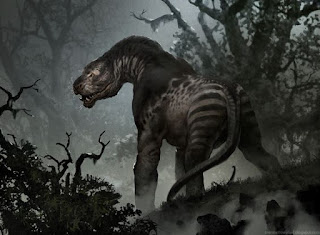 |
| somewhere inside the comet |
From afar, the Crillion Comet looks like a comet, an enormous rock burning through the Void. Behind this veil is a sleek cylinder, miles long, with a cross-section half of that. It is an ancient voidship, considered the first vessel able to carry its crew across the vastness of space. In the Dawn Era, Bruh Kreniik, an unrivaled Creationist of the ages, tasked the Lith-Crillion with its use. This highly advanced race were to observe the quick evolution of worlds, monitoring them for any primordial influences or other disturbance that may upset a world's natural development. This observation effort began in the Age of Creation, a time when worlds were forged from the energies and matter of Chaos. This was all new stuff, so Creationists like Bruh Kreniik went to great efforts to make sure that the efforts were not in vain. Creation resulted in the Dawn War, and the Dawn War led to the Demon Spawn War. This left behind war materials, dangerous spells, null mines, and other items considered too powerful to be left lying around. In addition to cataloging, monitoring and analyzing worlds, the Lith-Crillion were tasked with recovering things deemed problematic to an area's natural course of development.
Even though it was Bruh Kreniik's ship, the Crillion Comet did not escape the aforementioned wars. On dozens of occasions, the Crillion Comet and its Lith-Crillion crew, the only race that can pilot it, found themselves pressed into service, as a military transport or a refugees ship for those near extermination by a demon army or a world being torn apart by an aberrant monstrosity of the likes of the Nine-Tongued Worm.
After the wars, the Lith-Crillion continued to travel the stars. They continued the work of cleaning up, cataloging species, monitoring for ill influences. On some worlds they were known simply as the Inspectors, angelic and mysterious, perhaps even the gods themselves. They came and went, not seen again for decades. On other worlds, they set-up permanent bases, interfering in the affairs of the natives when they deemed it necessary (c.f. Maziggandîm Conflict). To reach so many distance places, the Crillion Comet was made to travel the Void in haste and secrecy. Even today, most see it only as a comet.
Until the Second Epoch, the Nil Koraaviik, authorities on matters pertaining to the stars, listed the Crillion Comet as a natural comet. They and other interested parties at Galzara's Watch, sponsored an expedition to proof this theory. In 1457, the Marching Twenty was commissioned to explore the phenomenon. Those that returned lasted mere days, each perishing from an incurable degenerating disorder. The majority never made it off the comet. The group's expedition journals describe one area to be taken up by strange apparatuses, thousands of them, and an assortment of cloning tanks, birthing ponds, maturation chambers and things rumored to be the province of Creationists. One theory for the Lith-Crillion's later disappearance is that the ship's birthing ponds quit working. Later research and expeditions to the ship gave good evidence that the Lith-Crillion made more of their kind only on this ship. It also gave credence to the idea that Lith-Crillion only experience the world around them as adults.
In 1534, the Golden Elite explored a section of the ship. They were on a mission to find one of the ship's Rift Spanners. After they found this ancient relic, it was used to get close to Merioss, where they launched the Elder Orb of Wyrms into the star.
It is an ark, a research enter, a flying ship, but most importantly a place to study the insects below. An engineering feat only matched by a score of gods or an entire race of supra-genius, highly advanced humanoids.
- Zarrek Lukko, from the Golden Elite Archives - "Crillion Comet, a Lith-Crillion Lab"
The Crillion Comet has strict safeguards in place for its use. To pilot, it requires a Lith-Crillion of balanced thoughts and of his or her own mind. When not piloted, which has been the case for thousands of years, the ship follows it last course, hopping across the vast reaches of the Void on Rift Spanners.
In the Lith-Crillion Era, the Crillion Comet served as a supply ship and collector of knowledge and relics. It supplied the Lith-Crillion research centers scattered across the Nawirrûs system. It served as transport for staff to new lands, but most importantly collector of lore and dangerous relics left behind from the Dawn War and the Demon Spawn War. Much of this stuff now lies in one of Bruh Kreniik's mountain vaults on some mysterious world. A place unnamed, hidden from the prying eye of even the gods. The Crillion Comet is still believed to have things that never reached storage, powerful items and lore that might cause problems if put into circulation.





